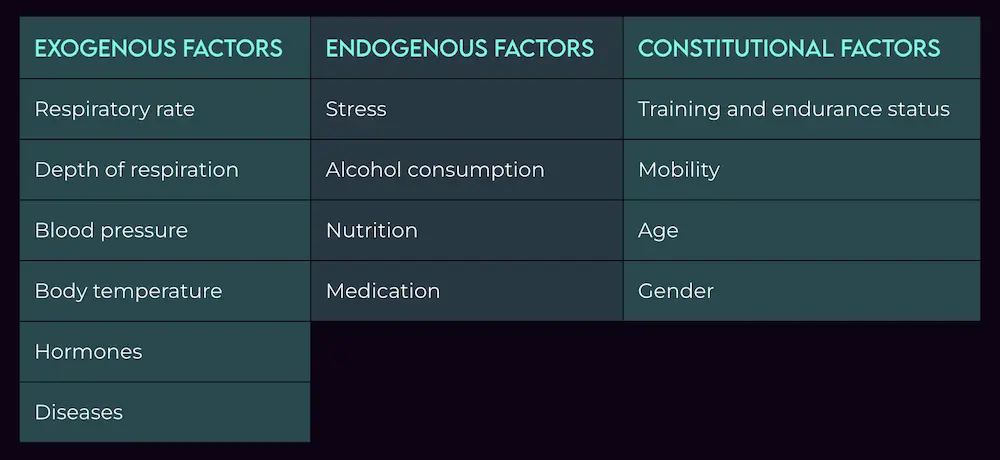In the current sports world, vital data are becoming increasingly important. On the one hand, they can be used to analyze the health of athletes. On the other hand, they also make it possible to determine the training control and the future load intensity. Certain key figures can also be interesting for amateur athletes. Most people can do something with the pulse or resting pulse as a guide for exertion during sport. Another indicator of physical fitness is heart rate variability (HRV). Physicians used to look at HRV primarily in the context of health care. Since HRV has been under the microscope in general medicine, its importance for athletes has also increased. This is also due to the fact that mini devices that measure heart rate variability are becoming more and more widespread. Could HRV measurement soon even be available in combination with communication systems in professional sports? Here you can find out!
Matchplan
To begin with, we would like to clarify the question of what heart rate variability says. The next step is how HRV measurement actually works. Many are also interested in whether there are normal values for heart rate variability. In this context, we also highlight the importance of HRV for competitive athletes and make a small digression on heart diseases in famous athletes, especially in football. To give you an idea of what influences heart rate variability, let’s look at the most important factors. For the hobby athletes among you, we also have some tips on how to improve your HRV. Finally, there is a small preview of how live monitoring could be further optimized in professional sports in the future.
What does heart rate variability say?
Let’s get straight to the most important question. What does heart rate variability actually say? Basically, HRV is the variation, i.e. the change in the distance between two heartbeats. Since in most cases, such as blood pressure values or resting heart rate, a lower value is better, another question naturally arises here. Which is better, high or low heart rate variability? This can be answered unequivocally. A low HRV is not desirable because the variance between heartbeats should be as high as possible. It should be noted, however, that the HRV can also be lower in trained competitive athletes.

But what controls this process? This task is performed by two components of our nervous system: the sympathetic and the parasympathetic. While the sympathetic nervous system is mainly active in a state of stress and increases heart rate, blood pressure and metabolism, the parasympathetic nervous system is responsible for recovery and slows down the processes mentioned. Accordingly, our heart must be able to adapt well to both states. This is influenced by factors inside and outside the body. But more on that later. The fact is that a low heart rate variability cannot guarantee that our body adapts optimally in both stages.
How is HRV measured?
As can be seen from the definition, HRV measurement is carried out by analyzing the variation of the interval between two heartbeats. These are also referred to as the RR interval (RRi) in technical jargon. This interval is measured in milliseconds (ms). The analysis is carried out using an electrocardiogram (ECG). Long-term EGKs are usually used for HRV measurement. In some studies, however, the period is only 5 minutes. ECG machines, familiar from visits to the doctor or hospital stay, are usually quite large and only intended for on-site use. In the meantime, however, there are also small systems that enable mobile vital data measurement. It is therefore also possible to measure the heart rate variability in amateur athletes, but also in competitive athletes while they are physically active.
Are there normal values for heart rate variability?
In the meantime, you may have asked yourself which values are desirable. The problem with this is that various institutions have already attempted to establish standard values for heart rate variability. However, these refer to periods that are too short. In addition, various influencing factors were not included in the determination. Overall, however, it is hardly possible to set standard values, since the heart rate variability is highly individual for each person. Comparisons are therefore difficult to make.
Importance of heart rate variability for athletes
While heart rate variability is important for everyone, it is especially important for athletes. HRV measurement opens up new possibilities for analyzing the performance of athletes. In addition, the key figure can be used to optimally vary the stress and to control the intensity in training and competition. As already mentioned, mini devices for live monitoring can now also be worn in these situations. They no longer represent a handicap, which would have been unthinkable a few decades ago. Over time, the RRi recorded by the mobile systems have increasingly approached the reliability of classic ECG systems. Under extreme stress, the HRV decreases. This can be a result of overtraining, for example. This effect was observed, for example, in triathletes after the competition.
Digression: heart disease in football
Again and again there are reports about famous athletes who had to struggle with heart problems. In football in particular, there have been several prominent cases in recent years. Christian Eriksen’s cardiac arrest at Euro 2021 is an incident that has stuck in the memory of many. Alphonso Davies, for example, also struggled with heart muscle inflammation in the Bundesliga. Spain legend Iker Casillas or Argentinian Sergio Agüero even had to end their careers as competitive athletes due to heart problems. Looking at these cases among famous athletes, it becomes clear why capturing metrics like heart rate variability is so important. Accordingly, the associated sports technology will be even more important in the future.
What affects heart rate variability?
So far, this post has focused a lot on the connection between physical activity and heart rate variability. However, there are other important influencing factors. Let’s start with the constitutional factors, which include training and endurance status. Accordingly, little mobility in everyday life has a bad effect on HRV. Age is also one of these factors. Many neglect their fitness, especially between the ages of 20 and 45, which can result in low HRV in old age. This in turn increases the risk of a heart attack. However, it should be noted that some decline in HRV with age is normal. Another constitutional factor is gender. The exogenous factors include stress as well as alcohol and drug consumption. Diet also affects heart rate variability. In addition, there are endogenous factors. Breathing is particularly important here, specifically the breathing rate and breathing depth. HRV is also affected by blood pressure and body temperature. Diseases such as diabetes also have a negative impact. Finally, there are external factors such as outside temperature and time of day.

How can amateur athletes improve their values?
Now we have looked at the individual factors. You may be wondering how amateur athletes can improve their HRV values, especially since some constitutional factors, such as age, cannot be changed. Aerobic endurance training is best for improving heart rate variability. Aerobic means oxygen is used up during exercise. This state is achieved through moderate exertion, such as slow swimming or jogging. You should pay attention to an appropriate intensity and duration. A heart rate of about 70-80 percent of the maximum is targeted. After just a few months, the effects of such training can be demonstrated. This method is suitable for both healthy people and many patients with cardiovascular diseases. In the latter case, however, it is essential to consult a doctor before training begins. The positive effect of aerobic endurance training lasts until about the age of 70. Even if you haven’t been active for a long time, you can quickly achieve positive effects. So no excuses!
In addition to sporting activities, stress reduction also contributes to an improvement in heart rate variability. One way to reduce stress is by taking breaks from work or by meditating. According to endogenous factors, better breathing technique can also have positive effects on HRV. In general, you should avoid the things mentioned that contribute to the deterioration. This also applies to athletes, since overtraining also results in heart rate variability that is too low.
Conclusion
Overall, it is clear that heart rate variability in sport is an important orientation to promote the performance and health of athletes. However, a healthy HRV is also very important for amateur athletes. At Coachwhisperer, we want to do our part to ensure that athletes can optimize their training management. For this we are developing an intercom system that also enables live monitoring. Since our hearable sits in the ear, it does not interfere with the movement in any way and thus allows vital data to be measured during the entire training session. If you have any further questions about our system, please send us a message!